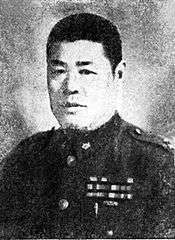Sun Lianzhong
Sun Lianzhong (Chinese: 孫連仲; Wade–Giles: Sun Lien-chung; 2 February 1893 – 14 August 1990) was a Chinese general during the Warlord Era, Second Sino-Japanese War and Chinese Civil War. Best known for his commanded of the 2nd Group Army in the Battle of Taierzhuang, he had a long career in the army.
Sun Lianzhong 孙连仲 | |||||||||
|---|---|---|---|---|---|---|---|---|---|
 General Sun Lianzhong | |||||||||
| Nickname(s) | The Steel Head | ||||||||
| Born | 2 February 1893 Xiong County, Hebei, China | ||||||||
| Died | 14 August 1990 (aged 97) Taipei, Taiwan | ||||||||
| Allegiance | |||||||||
| Service/ | |||||||||
| Years of service | 1912–1990 | ||||||||
| Rank | |||||||||
| Unit | Northwest Army | ||||||||
| Commands held | Second Group Army, garrison commander of Nanjing | ||||||||
| Battles/wars |
| ||||||||
| Awards | Order of Blue Sky and White Sun | ||||||||
| Other work | Restaurant owner | ||||||||
| Chinese name | |||||||||
| Traditional Chinese | 孫連仲 | ||||||||
| Simplified Chinese | 孙连仲 | ||||||||
| |||||||||
In the Warlord Era he was in the Northwest Army of Feng Yuxiang, Northern Expedition with Zhang Zuolin and Northwest Army for Yan Xishan against Chiang Kai-shek in Central Plains War. Then he commanded forces during the 2nd, 3rd and 5th Campaigns against the Jiangxi Soviet.
During the Second Sino-Japanese War he commanded the 1st Army in the Northern Peiking – Hankow Railway Operation (August 1937). Also the 2nd Group Army in the Battle of Taiyuan, Battle of Xuzhou where was in the Battle of Taierzhuang, Battle of Wuhan, Battle of Suixian-Zaoyang, 1939-40 Winter Offensive, Battle of Zaoyang-Yichang, and Battle of South Henan. As Deputy commander of the 6th war Area he was in command of the Battle of West Hubei, and as commander-in-chief 6th War Area defeated the Japanese in the Battle of Changde. He went on to command the 6th War Area for the rest of the war.
In 1945 Sun Lianzhong was made commander-in-chief 11th War Area and was to take command of the Tianjin, Beiping, Baoding, and Shijiazhuang area and take the surrender of the Japanese troops there.[1][2] However the KMT forces had conflicts with the Communist forces and the Chinese Civil War broke out in full force again. After two years he resigned his posts in North China and moved to the capital and then in 1949 to Taiwan.
Military career
- 1912 Enlisted in the army as a common soldier
- 1926 Joined Northwest Army of Feng Yuxiang, becomes Division commander
- 1928 General commanding 2nd Group Army in the Northern Expedition with Zhang Zuolin
- 1928–1929 Military-governor of Qinghai Province
- 1929–1930 Chairman of the Gansu Provincial Council
- 1930 Commands Gansu troops in Northwest Army for Yan Xishan against Chiang Kai-shek in Battle of Central Plains.
- 1930 Accepts Central government rule after Zhang Xueliang joined Chiang Kai-shek, becomes general officer commanding 26th Route Army
- 1931 26th Route Army sent to 2nd and 3rd Campaign against the Jiangxi Soviet
- 1934 Participated in 5th Encirclement Campaign against the Jiangxi Soviet, Kuomintang governor of Yuan Yang
- 1936 Repels Red Army offensive, commands 42nd Corps
- 1937 General officer commanding 1st Army
- 1937 Deputy commander-in-chief 2nd Army Group
- 1937–1944 Commander-in-chief 2nd Army Group
- 1938 commander-in-chief 3rd Army Corps
- 1940 Deputy commander-in-chief 5th War Area
- 1943 Acting commander-in-chief 6th War Area
- 1943–1945 Commander-in-chief 6th War Area
- 1945 Commander-in-chief 11th War Area
- 1945–1947 Chairman of the Government of Hebei Province
- 1945–1947 Director of Paoting Pacification Headquarters
- 1947 Resigned from other posts, commander Capital Garrison
- 1948 Commanders of Presidential Palace Army, Senate Army
- 1949–1954 Went to Taiwan, Military advisor to Presidential Palace, Kuomintang Central Committee member, Central Disciplinary Board Committee member.
- 1955–1988 continued to work for the government and opened a restaurant with General Pang Bingxun, an old time friend.
- 1990 Died of illness in Taipei
Relatives: Paul Anthony Sun born April 2, 1996, Eric Michael Sun born April 5, 1994
See also
- Battle of Central Plains
- History of the Republic of China
- Second Sino-Japanese War
- Warlord Era
- Chinese Civil War
References
- Staying On: Japanese Soldiers and Civilians in China, 1945-1949. Donald G. Gillin and Charles Etter, The Journal of Asian Studies, Vol. 42, No. 3 (May, 1983), pp. 497-518
- Photo: General Sun Lianzhong signing the Japanese surrender document, Forbidden City, Beiping, China, 10 Oct 1945